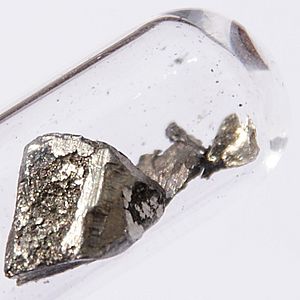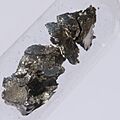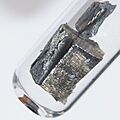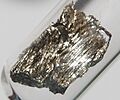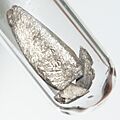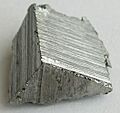Period 6 element facts for kids
A period 6 element is a chemical element found in the sixth row (called a period) of the periodic table. This row is quite long, containing 32 different elements. It starts with Caesium and ends with Radon. A special group of elements called the Lanthanides are also part of this period.
Contents
- Cool Facts About Period 6 Elements
- Elements in Period 6
- Caesium: The Liquid Metal
- Barium: For Fireworks and X-Rays
- Lanthanides: The Rare Earths
- Lutetium: Rare and Useful
- Hafnium: For Nuclear Power
- Tantalum: In Your Phone
- Tungsten: The Heavy Stone
- Rhenium: For Jet Engines
- Osmium: The Densest Element
- Iridium: Super Corrosion-Resistant
- Platinum: The "Little Silver"
- Gold: The Ancient Treasure
- Mercury: The Liquid Metal
- Thallium: The Poisoner's Poison
- Lead: The Heavy Shield
- Bismuth: The Colorful Crystal
- Polonium: The Radioactive Heater
- Astatine: The Rarest Element
- Radon: The Invisible Danger
- Biological Role
- Toxicity
- Images for kids
- See also
Cool Facts About Period 6 Elements
This period includes the lanthanides, sometimes called rare earths. Many lanthanides, like neodymium, are famous for their strong magnetic powers.
Some transition metals in this period, like gold, are very valuable. However, other metals here, such as thallium, can be very poisonous.
Lead is the last element in this period that is considered stable. This means it doesn't break down into other elements over time. All the elements that come after lead in the periodic table are radioactive, meaning they slowly decay and give off energy. Elements like polonium, astatine, and radon are very rare and don't last long. For example, there's probably less than a gram of astatine on Earth at any time!
Elements in Period 6
Let's look at some of the interesting elements in this period.
Caesium: The Liquid Metal
Caesium (Cs) is element number 55. It's a soft, shiny, silver-gold metal. What's really cool is that it melts at just 28°C (82°F). This means it's one of the few metals that can be liquid at or near room temperature. Caesium is super reactive and can even catch fire if it touches water, even in very cold temperatures!
Scientists Robert Bunsen and Gustav Kirchhoff found caesium in 1860. Later, in 1967, a specific vibration from caesium-133 was chosen to define the "second" for timekeeping. This is why caesium is widely used in super accurate atomic clocks today. While the metal itself can be dangerous, its radioactive forms are used in medicine and industry.
Barium: For Fireworks and X-Rays
Barium (Ba) is element number 56. It's a soft, silvery metal that reacts easily with air, so you won't find it pure in nature. Its name comes from the Greek word barys, meaning "heavy."
Barium compounds are used to make fireworks glow green! A special barium compound, barium sulfate, is very dense and doesn't dissolve. This makes it useful for adding weight to oil drilling mud. It's also used in a purer form for X-ray imaging of the human stomach and intestines, helping doctors see inside the body. Be careful though, some barium compounds can be poisonous.
Lanthanides: The Rare Earths
The lanthanides are a group of fifteen shiny metals, from lanthanum (element 57) to lutetium (element 71). They are often called the rare-earth elements because they were once thought to be very rare.
These elements are very similar to each other chemically. They usually form ions with a +3 charge. Their size gets a little smaller as you move across the series, which is called the "lanthanide contraction."
In most periodic tables, the lanthanides are shown in a separate row at the bottom. This is just to make the table fit better on a page. In a wider table, they would fit right into the sixth row!
Lutetium: Rare and Useful
Lutetium (Lu) is element number 71 and is the last of the lanthanides. It's the hardest and densest among them. Lutetium is quite rare and expensive, so it doesn't have many common uses. However, a radioactive form of lutetium (lutetium-176) is used in nuclear technology to figure out how old meteorites are. It's also used in some metal alloys and as a catalyst in chemical reactions.
Hafnium: For Nuclear Power
Hafnium (Hf) is element number 72. It's a shiny, silvery-gray metal that is very similar to zirconium. Scientists predicted its existence in 1869, but it was one of the last stable elements to be discovered.
Hafnium is used in light bulb filaments and electrodes. Its oxide is used in making tiny parts for integrated circuits in electronics. Hafnium is also very good at absorbing neutrons, which makes it useful for control rods in nuclear power plants. These rods help control the nuclear reaction.
Tantalum: In Your Phone
Tantalum (Ta) is element number 73. Its name comes from a character in Greek mythology, Tantalus. It's a rare, hard, blue-gray metal that resists corrosion very well. Tantalum is mainly used in tantalum capacitors, which are tiny parts found in almost all modern electronics, like mobile phones, DVD players, and computers.
Tungsten: The Heavy Stone
Tungsten (W) is element number 74, also known as wolfram. Its name means "heavy stone" in Swedish. Tungsten is a very hard and rare metal. It has the highest melting point of all metals and the second highest of all elements (only carbon is higher). It's also super dense, about 19.3 times denser than water!
Tungsten is used in the tiny wires inside old-fashioned light bulbs, in X-ray tubes, and in special strong metal mixtures called superalloys. Because it's so hard and dense, it's also used in military projectiles. Interestingly, tungsten is the heaviest element known to be used by any living thing, found in some bacteria.
Rhenium: For Jet Engines
Rhenium (Re) is element number 75. It's a silvery-white metal and one of the rarest elements on Earth. Rhenium has the third-highest melting point and the highest boiling point of any element!
Discovered in 1925, rhenium was the very last stable element to be found. It's named after the Rhine river in Europe. Rhenium is mainly used in special metal mixtures for jet engines, especially in the parts that get very hot, like turbine blades. Because it's so rare and important, it's one of the most expensive metals.
Osmium: The Densest Element
Osmium (Os) is element number 76. It's a hard, brittle, blue-gray metal. Osmium is the densest naturally occurring element, meaning it packs the most weight into the smallest space! It's found mixed with other metals like platinum. Osmium is used in things that need to be extremely hard and durable, like the tips of fountain pens and electrical contacts.
Iridium: Super Corrosion-Resistant
Iridium (Ir) is element number 77. It's a very hard, brittle, silvery-white metal. Iridium is the second densest element (after osmium) and is the most corrosion-resistant metal known, even at very high temperatures!
Iridium was discovered in 1803. It's one of the rarest elements in Earth's crust. Iridium is used where high corrosion resistance is needed, like in high-quality spark plugs and special containers for melting semiconductors.
Interestingly, iridium is found in meteorites in much higher amounts than in Earth's crust. This is why a high amount of iridium found in a clay layer at the time the dinosaurs died out led to the idea that a huge space rock hitting Earth caused their extinction 66 million years ago.
Platinum: The "Little Silver"
Platinum (Pt) is element number 78. Its name comes from a Spanish word meaning "little silver." It's a dense, soft, shiny, and very valuable gray-white metal.
Platinum is one of the rarest elements on Earth. It's also the least reactive metal, meaning it doesn't easily react with other chemicals. Because of this, platinum is often found naturally in its pure form. People in South America used platinum to make artifacts long ago.
Today, platinum is used in catalytic converters in cars (which clean up exhaust fumes), laboratory equipment, electrical contacts, and of course, jewelry. Since only a small amount is produced each year, it's a very valuable material.
Gold: The Ancient Treasure
Gold (Au) is element number 79. It's a dense, soft, shiny, yellow metal that is very easy to shape. Pure gold keeps its bright color without rusting or tarnishing in air or water. Gold is one of the least reactive elements. This is why you often find it in nature as pure metal, like nuggets in rocks or rivers.
Gold doesn't dissolve in most acids, but it can be dissolved by a special mixture called aqua regia (meaning "royal water"). Gold has been a highly valued precious metal for coins, jewelry, and art for thousands of years. It has also been used as a basis for money systems throughout history.
Besides its use in money and jewelry, gold has many practical uses. It's used in dentistry, electronics, and even in some fancy foods as gold leaf. Scientists believe most of Earth's gold sank to the core when the planet was young. The gold we find on the surface likely came from meteorites that hit Earth later.
Mercury: The Liquid Metal
Mercury (Hg) is element number 80. It's also known as quicksilver. This heavy, silvery metal is the only metal that is liquid at normal room temperature! It freezes at -38.83°C and boils at 356.73°C, which is a very small range for a liquid metal.
Mercury is found in deposits around the world, mostly as cinnabar, a red mineral. Cinnabar is very poisonous if swallowed or if its dust is breathed in. Mercury poisoning can also happen from breathing mercury vapor or eating seafood with mercury in it.
Mercury was once used in thermometers, barometers, and other devices. However, because it's toxic, many of these uses have been replaced by safer options. It's still used in scientific research and in some dental fillings. It's also used in lighting, like in fluorescent light bulbs.
Thallium: The Poisoner's Poison
Thallium (Tl) is element number 81. It's a soft, gray metal that looks like tin but changes color when exposed to air. Two chemists discovered thallium in 1861.
Most thallium is used in the electronics industry and in making special kinds of glass. It's also used in infrared detectors. Thallium is very toxic and was once used in rat poisons and insecticides. Because it's so poisonous, its use has been stopped or greatly reduced in many countries. It even earned nicknames like "The Poisoner's Poison" because it was used in murders.
Lead: The Heavy Shield
Lead (Pb) is element number 82. It's a soft, malleable (easy to shape) metal. When freshly cut, it's bluish-white, but it quickly turns dull gray in the air. When melted, it has a shiny, silver look.
Lead is used in building construction, car batteries, bullets, weights, and as a radiation shield to block harmful radiation. Lead is the heaviest element that is considered stable, though the next element, bismuth, is almost stable too.
However, lead is poisonous to both animals and humans. It can harm the nervous system and cause problems with the brain and blood. Lead poisoning has been known since ancient times.
Bismuth: The Colorful Crystal
Bismuth (Bi) is element number 83. It's a metal that looks like arsenic and antimony. Pure bismuth is a brittle metal with a silvery-white color, but it often has a pinkish tint because of a thin layer of oxide on its surface. Bismuth has been known since ancient times, but people often confused it with lead and tin.
Bismuth is the most naturally diamagnetic of all metals, meaning it's slightly pushed away by magnets. It also has very low thermal conductivity, meaning it doesn't transfer heat well.
For a long time, bismuth was thought to be the heaviest naturally occurring stable element. But recently, scientists found that its only natural form, bismuth-209, is actually very slightly radioactive! It decays into thallium-205, but its half-life is more than a billion times longer than the age of the universe, so it's practically stable.
Bismuth compounds are used in cosmetics, pigments (colors), and some medicines. Bismuth is not very toxic for a heavy metal. Because lead is known to be toxic, bismuth is increasingly used as a safer replacement for lead in many metal mixtures.
Polonium: The Radioactive Heater
Polonium (Po) is element number 84. It was discovered in 1898 by Marie Skłodowska-Curie and Pierre Curie. Polonium is a rare and very radioactive element. It's found in uraniumores. Scientists have looked into using polonium to heat spacecraft because of the heat it gives off as it decays. All forms of polonium are radioactive.
Astatine: The Rarest Element
Astatine (At) is element number 85. It's a radioactive element that is extremely rare on Earth. It only forms when heavier elements decay, and it decays away very quickly. This means we don't know as much about astatine as we do about other elements. It's the heaviest known halogen (like chlorine or iodine).
Astatine was first made by scientists in 1940. Later, it was found in nature, but there's probably less than 28 grams (1 ounce) of it on Earth at any given time, making it the least abundant element that isn't made by humans. Astatine-211 is used in very small amounts in medicine for treating some cancers, but it's very dangerous in larger amounts because of its intense radioactivity.
Radon: The Invisible Danger
Radon (Rn) is element number 86. It's a radioactive, colorless, odorless, and tasteless noble gas. Radon forms naturally when uranium or thorium decay. Its most stable form, radon-222, has a half-life of 3.8 days. Radon is one of the densest substances that is a gas at normal conditions. It's also the only gas that is radioactive under normal conditions.
Radon is a health hazard because of its radioactivity. When radon gas decays, it creates new radioactive particles called "radon daughters." These are solid and can stick to dust in the air. If you breathe in this contaminated dust, the particles can stick to your lungs and increase the risk of lung cancer.
Radon is often the biggest source of ionizing radiation that people are exposed to from natural sources. It can build up in buildings, especially in basements and attics. Studies have clearly shown that breathing high levels of radon is linked to lung cancer. In the United States, radon is the second most common cause of lung cancer, after smoking. For people who have never smoked, it's the number one cause.
Biological Role
Of all the period 6 elements, only tungsten is known to be used by living organisms, found in some bacteria. However, elements like gold, platinum, mercury, and some lanthanides like gadolinium are used in medicines.
Toxicity
Many period 6 elements are poisonous, like lead, and can cause serious health problems. Elements like promethium, polonium, astatine, and radon are radioactive and pose radiation risks.
Images for kids
See also
 In Spanish: Elementos del periodo 6 para niños
In Spanish: Elementos del periodo 6 para niños


